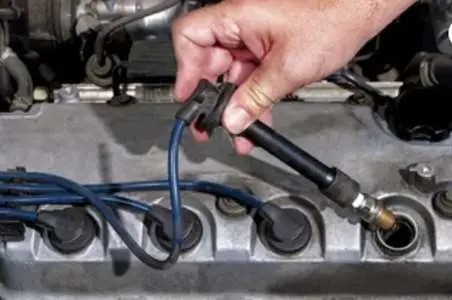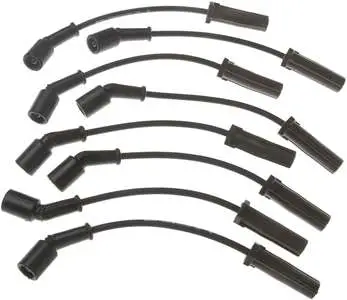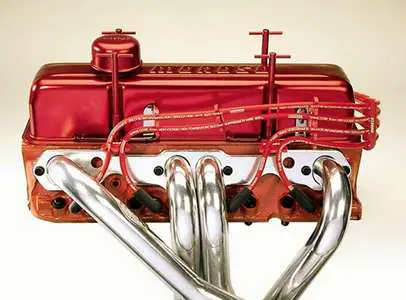
A spark plug is a little but essential component of a car because The engine gets its charge for ignition through the spark plug wires.
So, if you are looking to identify a damaged spark plug wires, you’re in the right place. Before getting onto the symptoms and solutions, let’s see how these wires serve in the vehicle.
The wires are responsible for taking current from the ignition coil to the spark plug so that the vehicle can start.
Sometimes, a problem in the spark plug or the wires can lead to the engine going out of order, so it is essential to keep the pin and the cables in good condition.
Symptoms of Bad Spark Plug Wires:
- Crack or Cuts in Wires
- Hard to Start
- Hesitation on Acceleration
- Engine misfire/missing
- Engine Light Turned on
- Raw Gas Odor at the Tailpipe
- A Ticking Noise that changes Frequency with RPMs
- Poor Fuel Economy
Let’s go deep into each symptom to know more about them. These are some common and obvious symptoms that you can easily spot to identify a bad spark plug wire.
Physical Inspection
I always recommend physical inspection as the first step instead of going to an auto shop. It saves you time and money, and why rely on some else when you can do it better yourself.
Start by looking under the good light at all the lead wires. Next, check the spark plug wire insulation for cuts or slits. Also, give spark plug rubber boot and the connections a quick inspection; any crack or splits in there can be the cause.
Hard to Start
If you are wondering, Can bad spark plug wires cause a car not to start? Then yes! If the cables are too damaged to send enough current for ignition, the car won’t start.
If you cannot put the engine into the ignition, there can be a problem with the spark plug wires as these provide current that burns the fuel/oxygen mixture.
Hesitation on Acceleration
Faulty spark plug wires can restrict the current flow, which may lead to the engine hesitating on accelerate.
Remember that you won’t feel resistance in case of bad wires while accelerating, but the engine won’t just accelerate as hard as you push on the pedal.
Engine Misfire/Missing
Damaged wires often lead to engine misfiring as they cause electrical interference, resulting in incomplete combustion in the engine.
Engine Light Turned On
This symptom is after the misfiring of the engine. When this happens, the engine light turns on.
If you notice the engine light is coming on for no reason, it can point towards fault in the sparkplug wires.
Some Other Symptoms
There might be some other indications that can point towards faulty spark plug wires. However, these might seem unrelated to them, which is why most of us tend to ignore them.
A raw gas odor from the tailpipe shows that an excessive amount of fuel is going into the engine. It means the engine is burning more than it need to combust.
Furthermore, a ticking sound that changes the pitch with RPM can also point towards lousy spark plug wires.
Poor fuel economy is another factor that counts when it comes to damaged spark plug wires, so consider that too.
What Causes Spark Plug Wires to go Bad?
There many reasons why the sparkplug wires can become faulty, among which the most common one is the surrounding environment.
The engine generates and radiates a lot of heat which can cause the insulation to melt and damage the wires. With the insulation gone, there is a high risk of sparking in there that can cause damage.
Another problem the engine is responsible for is the vibration which can stretch the wires and result in a loose electrical connection.
A bad battery might also ruin the spark plug wires. To dodge this problem, make sure to use a healthy battery and spark plug wire holders.
There’s more; the spark plug itself can be the culprit too. If the plug is faulty, it will draw more current to get the engine going, which affects the wires’ life.
Lastly, don’t forget to check the spark plug gap. If there is more or less gap than usual, it can also cause the wires to go bad fast.
How much Resistance should be in a Spark Plug Wire?
The answer to your question lies in the quality of the spark plug wires. Good ones offer around 3000 to 5000 Ohms per foot.
You need to be careful that it remains consistent from one to the other wire. If you get random reading, it can be because of a bad connection from your meter.
Check meter inherent resistance and see if it is consistent. You can use the average method for this if the resistance is anywhere near 10,000 ohm/ft. It’s bad news. You’ll need to change wires every ten years or so.
It will help if you keep something in mind when it comes to the resistance of the spark plug wires.
Wires with higher resistance work better for reducing radiation that means less radio interference noise. However, it doesn’t affect the performance of the engine or longevity when the spark plugs are still in their useful life.
- Spark plug wire resistance too low
Too low resistance can be problematic as they can easily conduct EMF/RFI through the insulation.
- Spark plug wire resistance too high
If the resistance is too high, there won’t be enough current reaching the plug. When the current isn’t enough to ignite the fuel mixture, the engine does not come on.
How to Test Spark Plug Wires with a Multimeter?
Over time, spark plug wires wear out and cause problems with the engine. Before testing the wires with a multimeter, remember that the length and type of wires you use can affect the results.
Types of Spark Plug Wires
- A copper cable offers resistance from 1 – 6,500 ohms.
- It can range from 2000 to 8000 ohms per meter for inductive wires.
- Lastly, the resistance is much higher for carbon wires, ranging from 10,000 to 23,000 ohms per meter (3,000 to 7,000 ohms per foot).
Process of Testing Spark Plug Wires With a Multimeter
- To test the wires, start by measuring the length of the wires. You can measure it from the boot, but remember the terminal inside is about an inch from the boot, and the wire start about ½ inch back from there.
- Set the multimeter on the 20K setting as it gives value in the 10,000 range, which is easier to read.
- Touch the test probes on each terminal and take the reading.
If the reading is in the generic range, you are good, but you’ll need to replace the wires if it is higher or lower. See the latest price on Amazon.
How to Check Spark Plug Wires with Water?
Yes, you read that right. You can test spark plug wires for damage with water. First, you need to visually inspect the wires for cuts, slit, or other physical damage. For this method to work,
I suggest doing it at night with no lights around so you can notice if any sparking occurs. Get water in a spray bottle and do a couple of spritz from a distance on the wiring area. You’ll either see small sparks in case of faulty wires or hear tiny tick noises.
Bonus: Pull off plug leads and replace them with each other and note which cylinder affects the running of the engine you can easily find the faulty wire. Buy high-quality new wires right now.
Why do I Get a Shock when I Touch the Spark Plug Wire?
The complaint of spark plugs shocking people is prevalent, yet I have heard misleading like spark plug conducting charges. All of it is untrue.
The real reason behind the plug shocking you is the damaged insulation of the wires; there can be a small slit or crack in the insulation, which is causing the electrocution.
The voltage in the spark plug is high, close to 1000V, depending on your system. When you touch it while the engine is on, the only barrier between that high voltage is the thickness rubber boot.
If you are grounded, you are completing the circuit so that you will get a shock. Of course, since the current is low, you won’t get hurt, but yes, it’s an eye-opening experience, literally.
How to Stop Spark Plug Wires from Arcing?
A loose connection between the plugs and the coil due to the lousy ground can lead to arcing. Let’s put it that way if the river is blocked; the water makes its way through another path.
Similarly, when the arch cannot find a suitable ground plug gap, it makes way elsewhere at the next weakest point.
If you got a spark arcing from the plug wire to the ground, it cannot jump the plug gap and thus has made an alternative easier.
It commonly indicates a defective spark plug or bad plug wire. However, there can also be something up inside the cylinder-like low compression, coolant, etc., which kills the plugs when it’s under compression.
But wait, there is more. A weak coil might also be the cause of the problem. If the coil is having a hard time putting out enough voltage to jump, the plug gap is compressed in the cylinder.
In this case, the coil lowers the voltage and provides the spark an easier route to the ground via the plug wire boot.
Can Spark Plug Wires Touch Each Other?
Spark plugs touching is bad news! Don’t ever let them come in contact with each other or the metallic base of the engine. To prevent it from happening, use non-conductive plug wire looms. You can also use spark plug wire holders to keep the plug wires separated by about ½ inch or more.
Here is a good one if you are looking to make a purchase.
Moroso – 72172 WIRE LOOM KIT
These wire looms are a universal fit; the package includes hole kit, hole looms, hole wire separators, and hole separators.
Just remember one thing. This kit is not suitable for a vehicle that has spark plugs at an angle; it is only compatible with straight ones. See the latest price on Amazon.
Related Article: How to Tell if a Spark Plug is Misfiring



